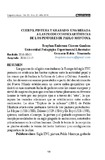Mostrar el registro sencillo del ítem
Cuerpo, Pintura y Grabado: Una mirada a las producciones artísticas de los pintores de Pablo Montoya
| dc.rights.license | http://creativecommons.org/licenses/by-nc-sa/3.0/ve/ | es_VE |
| dc.contributor.author | Cáceres Gamboa, Brayhan Enderson | |
| dc.date.accessioned | 2018-04-09T17:49:05Z | |
| dc.date.available | 2018-04-09T17:49:05Z | |
| dc.date.issued | 2016-01 | |
| dc.identifier.issn | 1315-9435 | |
| dc.identifier.uri | http://www.saber.ula.ve/handle/123456789/44544 | |
| dc.description.abstract | Las guerras de religión suscitadas en la Europa del siglo XVI pusieron en evidencia las fuertes rupturas entre la autoridad papal y los reinos que defendían la Reforma de Lutero y Calvino. Aunado a ello, los diversos escenarios presentados a partir del descubrimiento del Nuevo Mundo establecieron un nuevo orden geopolítico que derivó en una constante lucha de poderes entre los reinos europeos y sirvió de inspiración para que muchos artistas plasmaran en diversos lienzos lo visto por sus propios ojos o a través del “otro”, lo que supuso las variadas relaciones que se establecieron entre ambos continentes. La obra “Tríptico de la infamia” (2014) de Pablo Montoya retrata estas posturas a través de tres pintores protestantes: Le Moyne (1533-1588), Dubois (1529-1584) y De Bry (1528-1598), quienes, mediante el cuerpo, la pintura y el grabado expresaron las complejas realidades de un siglo plagado de ambiciones, catástrofes y desolaciones en la cultura humana. Desde la teoría de la recepción se plantea abordar la visión del lector histórico y su configuración pragmática de la obra. | es_VE |
| dc.language.iso | es | es_VE |
| dc.publisher | Saber ULA | es_VE |
| dc.rights | info:eu-repo/semantics/openAccess | es_VE |
| dc.subject | Siglo XVI | es_VE |
| dc.subject | Pintura | es_VE |
| dc.subject | Pablo Montoya | es_VE |
| dc.subject | Grabado | es_VE |
| dc.title | Cuerpo, Pintura y Grabado: Una mirada a las producciones artísticas de los pintores de Pablo Montoya | es_VE |
| dc.title.alternative | Body, painting and engraving: A look at the artistic productions of Pablo Montoya painters | es_VE |
| dc.type | info:eu-repo/semantics/article | es_VE |
| dc.description.abstract1 | The religion wars aroused in sixteenth-century Europe brought to light the sharp ruptures between papal authority and the kingdoms that defended the Reformation of Luther and Calvin. Added to this, the various scenarios presented from the discovery of the New World established a new geopolitical order that led to a constant struggle of powers between the European kingdoms and served as an inspiration for many artists to paint on various canvases seen by their own eyes or through the “other”, which supposed the varied relationships that were established between both continents. The work “Tríptico de la Infamia” (2014) by Pablo Montoya portrays these positions through three Protestant painters: Le Moyne (1533- 1588), Dubois (1529-1584) and De Bry (1528-1598), who, through the body, the painting and the engraving expressed the complex realities of a century full of ambitions, catastrophes and desolations in human culture. From the reception theory, it is proposed to approach the historical reader’s vision and its pragmatic configuration of the work. | es_VE |
| dc.description.colacion | 108-129 | es_VE |
| dc.description.email | brayhancaceres@gmail.com | es_VE |
| dc.description.frecuencia | Anual | |
| dc.publisher.pais | Venezuela | es_VE |
| dc.subject.facultad | Núcleo Táchira (NUTULA) | es_VE |
| dc.subject.grupoinv | Grupo de Investigación en Literatura Latinoamericana y del Caribe | |
| dc.subject.institucion | Universidad de Los Andes | es_VE |
| dc.subject.keywords | 16th century | es_VE |
| dc.subject.keywords | Painting | es_VE |
| dc.subject.keywords | Pablo Montoya | es_VE |
| dc.subject.keywords | Engraving | es_VE |
| dc.subject.publicacionelectronica | Contexto | |
| dc.subject.seccion | Artículo | es_VE |
| dc.subject.thematiccategory | Artes y Humanidades | es_VE |
| dc.subject.tipo | Revistas | es_VE |
| dc.type.media | Texto | es_VE |
Ficheros en el ítem
Este ítem aparece en la(s) siguiente(s) colección(ones)
-
Contexto - Segunda etapa. Volumen 020, No. 022
Enero-Diciembre 2016


